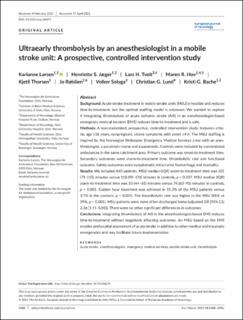| dc.contributor.author | Larsen, Karianne | |
| dc.contributor.author | Jæger, Henriette S, | |
| dc.contributor.author | Tveit, Lars H. | |
| dc.contributor.author | Hov, Maren R, | |
| dc.contributor.author | Thorsen, Kjetil | |
| dc.contributor.author | Røislien, Jo | |
| dc.contributor.author | Solyga, Volker | |
| dc.contributor.author | Lund, Christian G. | |
| dc.contributor.author | Bache, Kristi G. | |
| dc.date.accessioned | 2021-09-30T11:59:04Z | |
| dc.date.available | 2021-09-30T11:59:04Z | |
| dc.date.created | 2021-07-09T14:12:39Z | |
| dc.date.issued | 2021-04-23 | |
| dc.identifier.citation | European Journal of Neurology. 2021, 1-10. | en_US |
| dc.identifier.issn | 1351-5101 | |
| dc.identifier.issn | 1468-1331 | |
| dc.identifier.uri | https://hdl.handle.net/11250/2786635 | |
| dc.description.abstract | Background: Acute stroke treatment in mobile stroke units (MSU) is feasible and reduces time-to-treatment, but the optimal staffing model is unknown. We wanted to explore if integrating thrombolysis of acute ischemic stroke (AIS) in an anesthesiologist-based emergency medical services (EMS) reduces time-to-treatment and is safe. Methods: A nonrandomized, prospective, controlled intervention study. Inclusion criteria: age ≥18 years, nonpregnant, stroke symptoms with onset ≤4 h. The MSU staffing is inspired by the Norwegian Helicopter Emergency Medical Services crew with an anesthesiologist, a paramedic-nurse and a paramedic. Controls were included by conventional ambulances in the same catchment area. Primary outcome was onset-to-treatment time. Secondary outcomes were alarm-to-treatment time, thrombolytic rate and functional outcome. Safety outcomes were symptomatic intracranial hemorrhage and mortality. Results: We included 440 patients. MSU median (IQR) onset-to-treatment time was 101 (71–155) minutes versus 118 (90–176) minutes in controls, p = 0.007. MSU median (IQR) alarm-to-treatment time was 53 (44–65) minutes versus 74 (63–95) minutes in controls, p < 0.001. Golden hour treatment was achieved in 15.2% of the MSU patients versus 3.7% in the controls, p = 0.005. The thrombolytic rate was higher in the MSU (81% vs 59%, p = 0.001). MSU patients were more often discharged home (adjusted OR [95% CI]: 2.36 [1.11–5.03]). There were no other significant differences in outcomes. Conclusions: Integrating thrombolysis of AIS in the anesthesiologist-based EMS reduces time-to-treatment without negatively affecting outcomes. An MSU based on the EMS enables prehospital assessment of acute stroke in addition to other medical and traumatic emergencies and may facilitate future implementation. | en_US |
| dc.description.sponsorship | The study was funded by the Norwegian Air Ambulance Foundation. | en_US |
| dc.language.iso | eng | en_US |
| dc.publisher | Wiley | en_US |
| dc.relation.ispartofseries | Wiley;Volume 28, Issue 8 | |
| dc.rights | Attribution-NonCommercial-NoDerivatives 4.0 Internasjonal | * |
| dc.rights.uri | http://creativecommons.org/licenses/by-nc-nd/4.0/deed.no | * |
| dc.subject | Acute strokes | en_US |
| dc.subject | Anesthesiologists | en_US |
| dc.subject | Emergency medical services | en_US |
| dc.subject | Mobile stroke units | en_US |
| dc.subject | Thrombolysis | en_US |
| dc.title | Ultraearly thrombolysis by an anesthesiologist in a mobile stroke unit: A prospective, controlled intervention study | en_US |
| dc.type | Peer reviewed | en_US |
| dc.type | Journal article | en_US |
| dc.description.version | publishedVersion | en_US |
| dc.rights.holder | © 2021 The Authors | en_US |
| cristin.ispublished | true | |
| cristin.fulltext | original | |
| cristin.qualitycode | 2 | |
| dc.identifier.doi | https://doi.org/10.1111/ene.14877 | |
| dc.identifier.cristin | 1921195 | |
| dc.source.journal | European Journal of Neurology | en_US |
| dc.source.volume | 28 | en_US |
| dc.source.issue | 8 | en_US |
| dc.source.pagenumber | 2488-2496 | en_US |

